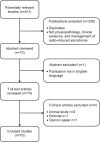Xerostomia induced by radiotherapy: an overview of the physiopathology, clinical evidence, and management of the oral damage
- PMID: 25691810
- PMCID: PMC4325830
- DOI: 10.2147/TCRM.S70652
Xerostomia induced by radiotherapy: an overview of the physiopathology, clinical evidence, and management of the oral damage
Abstract
Background: The irradiation of head and neck cancer (HNC) often causes damage to the salivary glands. The resulting salivary gland hypofunction and xerostomia seriously reduce the patient's quality of life.
Purpose: To analyze the literature of actual management strategies for radiation-induced hypofunction and xerostomia in HNC patients.
Methods: MEDLINE/PubMed and the Cochrane Library databases were electronically evaluated for articles published from January 1, 1970, to June 30, 2013. Two reviewers independently screened and included papers according to the predefined selection criteria.
Results: Sixty-one articles met the inclusion criteria. The systematic review of the literature suggests that the most suitable methods for managing the clinical and pathophysiological consequences of HNC radiotherapy might be the pharmacological approach, for example, through the use of cholinergic agonists when residual secretory capacity is still present, and the use of salivary substitutes. In addition, a modified diet and the patient's motivation to enhance oral hygiene can lead to a significant improvement.
Conclusion: Radiation-induced xerostomia could be considered a multifactorial disease. It could depend on the type of cancer treatment and the cumulative radiation dose to the gland tissue. A preventive approach and the correct treatment of the particular radiotherapeutic patient can help to improve the condition of xerostomia.
Keywords: management strategies; radiation-induced xerostomia; salivary gland hypofunction.
Figures
References
-
- Bivona PL. Xerostomia. A common problem among the elderly. N Y State Dent J. 1998;64:46–52. - PubMed
-
- Cassolato SF, Turnbull RS. Xerostomia: clinical aspects and treatment. Gerodontology. 2003;20:64–77. - PubMed
-
- Waltimo T, Christen S, Meurman JH, Filippi A. Dental care of patients with leukemia. Schweiz Monatsschr Zahnmed. 2005;115:308–315. - PubMed
-
- Brand HS, Bots CP, Raber-Durlacher E. Xerostomia and chronic oral complications among patients treated with haematopoietic stem cell transplantation. Br Dent J. 2009;207:E17. - PubMed
-
- Gupta A, Epstein JB, Sroussi H. Hyposalivation in elderly patients. J Can Dent Assoc. 2006;72:841–846. - PubMed
Publication types
LinkOut - more resources
Full Text Sources
Other Literature Sources
Medical
Miscellaneous





